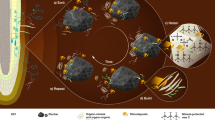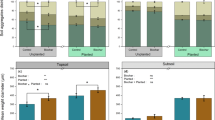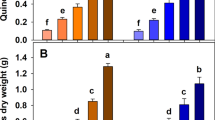Abstract
Biochar can increase the stable C content of soil. However, studies on the longer-term role of plant–soil–biochar interactions and the consequent changes to native soil organic carbon (SOC) are lacking. Periodic 13CO2 pulse labelling of ryegrass was used to monitor belowground C allocation, SOC priming, and stabilization of root-derived C for a 15-month period—commencing 8.2 years after biochar (Eucalyptus saligna, 550 °C) was amended into a subtropical ferralsol. We found that field-aged biochar enhanced the belowground recovery of new root-derived C (13C) by 20%, and facilitated negative rhizosphere priming (it slowed SOC mineralization by 5.5%, that is, 46 g CO2-C m−2 yr−1). Retention of root-derived 13C in the stable organo-mineral fraction (<53 μm) was also increased (6%, P < 0.05). Through synchrotron-based spectroscopic analysis of bulk soil, field-aged biochar and microaggregates (<250 μm), we demonstrate that biochar accelerates the formation of microaggregates via organo-mineral interactions, resulting in the stabilization and accumulation of SOC in a rhodic ferralsol.
This is a preview of subscription content, access via your institution
Access options
Access Nature and 54 other Nature Portfolio journals
Get Nature+, our best-value online-access subscription
$29.99 / 30 days
cancel any time
Subscribe to this journal
Receive 12 print issues and online access
$209.00 per year
only $17.42 per issue
Buy this article
- Purchase on Springer Link
- Instant access to full article PDF
Prices may be subject to local taxes which are calculated during checkout




Similar content being viewed by others
References
Lal, R. Managing soils and ecosystems for mitigating anthropogenic carbon emissions and advancing global food security. BioScience 60, 708–721 (2010).
Antle, J. M., Capalbo, S. M., Mooney, S., Elliott, E. T. & Paustian, K. H. Economic analysis of agricultural soil carbon sequestration: an integrated assessment approach. J. Agric. Res. Econ. 26, 344–367 (2001).
Ogle, S. M., Breidt, F. J. & Paustian, K. Agricultural management impacts on soil organic carbon storage under moist and dry climatic conditions of temperate and tropical regions. Biogeochemistry 72, 87–121 (2005).
Stocking, M. A. Tropical soils and food security: the next 50 years. Science 302, 1356–1359 (2003).
Smith, P. Soil carbon sequestration and biochar as negative emission technologies. Glob. Change Biol. 22, 1315–1324 (2016).
Woolf, D., Amonette, J. E., Street–Perrott, F. A., Lehmann, J. & Joseph, S. Sustainable biochar to mitigate global climate change. Nat. Commun. 1, 56 (2010).
Singh, B. P. & Cowie, A. L. Long-term influence of biochar on native organic carbon mineralisation in a low-carbon clayey soil. Sci. Rep. 4, 3687 (2014).
Zimmerman, A. R. & Gao, B. in Biochar and Soil Biota (eds Ladygina, N. & Rineau, F.) 1–40 (CRC Press, 2013).
Van Zwieten, L. et al. Biochar for Environmental Management: Science, Technology and Implementation 2nd edn, 489–5209 (Routledge, 2015).
Novak, J. M. et al. Short–term CO2 mineralization after additions of biochar and switchgrass to a Typic Kandiudult. Geoderma 154, 281–288 (2010).
Van Zwieten, L. et al. Effects of biochar from slow pyrolysis of papermill waste on agronomic performance and soil fertility. Plant Soil 327, 235–246 (2010).
Keith, A., Singh, B. & Dijkstra, F. A. Biochar reduces the rhizosphere priming effect on soil organic carbon. Soil Biol. Biochem. 88, 372–379 (2015).
Weng, Z. et al. Plant–biochar interactions drive the negative priming of soil organic carbon in an annual ryegrass field system. Soil Biol. Biochem. 90, 111–121 (2015).
Whitman, T., Enders, A. & Lehmann, J. Pyrogenic carbon additions to soil counteract positive priming of soil carbon mineralization by plants. Soil Biol. Biochem. 73, 33–41 (2014).
Maestrini, B., Nannipieri, P. & Abiven, S. A meta-analysis on pyrogenic organic matter induced priming effect. Glob. Change Biol. Bioenergy 7, 577–590 (2014).
Luo, Y., Durenkamp, M., De Nobili, M., Lin, Q. & Brookes, P. C. Short term soil priming effects and the mineralisation of biochar following its incorporation to soils of different pH. Soil Biol. Biochem. 43, 2304–2314 (2011).
Kuzyakov, Y., Subbotina, I., Chen, H., Bogomolova, I. & Xu, X. Black carbon decomposition and incorporation into soil microbial biomass estimated by 14C labeling. Soil Biol. Biochem. 41, 210–219 (2009).
Six, J., Elliott, E. T., Paustian, K. & Doran, J. W. Aggregation and soil organic matter accumulation in cultivated and native grassland soils. Soil Sci. Soc. Am. J. 62, 1367–1377 (1998).
Kong, A. Y., Six, J., Bryant, D. C., Denison, R. F. & Van Kessel, C. The relationship between carbon input, aggregation, and soil organic carbon stabilization in sustainable cropping systems. Soil Sci. Soc. Am. J. 69, 1078–1085 (2005).
Kleber, M. et al. Chapter one–Mineral–organic associations: formation, properties, and relevance in soil environments. Adv. Agron. 130, 1–140 (2015).
Torn, M. S., Trumbore, S. E., Chadwick, O. A., Vitousek, P. M. & Hendricks, D. M. Mineral control of soil organic carbon storage and turnover. Nature 389, 170–173 (1997).
Mikutta, R., Kleber, M. & Jahn, R. Poorly crystalline minerals protect organic carbon in clay subfractions from acid subsoil horizons. Geoderma 128, 106–115 (2005).
Denef, K., Plante, A. & Six, J. Soil Carbon Dynamics: An Integrated Methodology 91–126 (Cambridge Univ. Press, 2009).
Singh, B. P., Cowie, A. L. & Smernik, R. J. Biochar carbon stability in a clayey soil as a function of feedstock and pyrolysis temperature. Environ. Sci. Technol. 46, 11770–11778 (2012).
Joseph, S. D. et al. An investigation into the reactions of biochar in soil. Aust. J. Soil Res. 48, 501–515 (2010).
Keiluweit, M. et al. Mineral protection of soil carbon counteracted by root exudates. Nat. Clim. Change 5, 588–595 (2015).
Haichar, F. e. Z., Santaella, C., Heulin, T. & Achouak, W. Root exudates mediated interactions belowground. Soil Biol. Biochem. 77, 69–80 (2014).
Ventura, M. et al. Effect of biochar addition on soil respiration partitioning and root dynamics in an apple orchard. Eur. J. Soil Sci. 65, 186–195 (2014).
Whitman, T., Singh, B. P. & Zimmerman, A. Biochar for Environmental Management: Science, Technology and Implementation 2nd edn, 455–488 (Routledge, 2015).
Slavich, P. G. et al. Contrasting effects of manure and green waste biochars on the properties of an acidic ferralsol and productivity of a subtropical pasture. Plant Soil 366, 213–227 (2013).
Farquhar, G. D., Ehleringer, J. R. & Hubick, K. T. Carbon isotope discrimination and photosynthesis. Annu. Rev. Plant Biol. 40, 503–537 (1989).
Lehmann, J. et al. Biochar effects on soil biota—a review. Soil Biol. Biochem. 43, 1812–1836 (2011).
Liang, B. et al. Black carbon affects the cycling of non-black carbon in soil. Organ. Geochem. 41, 206–213 (2010).
Lawrinenko, M. & Laird, D. A. Anion exchange capacity of biochar. Green Chem. 17, 4628–4636 (2015).
Desjardins, T., Barros, E., Sarrazin, M., Girardin, C. & Mariotti, A. Effects of forest conversion to pasture on soil carbon content and dynamics in Brazilian Amazonia. Agric. Ecosyst. Environ. 103, 365–373 (2004).
Solomon, D. et al. Micro- and nano-environments of carbon sequestration: Multi-element STXM–NEXAFS spectromicroscopy assessment of microbial carbon and mineral associations. Chem. Geol. 329, 53–73 (2012).
Solomon, D. et al. Molecular signature and sources of biochemical recalcitrance of organic C in Amazonian Dark Earths. Geochim. Cosmochim. Acta 71, 2285–2298 (2007).
Heymann, K., Lehmann, J., Solomon, D., Schmidt, M. W. & Regier, T. C 1s K–edge near edge X–ray absorption fine structure (NEXAFS) spectroscopy for characterizing functional group chemistry of black carbon. Organ. Geochem. 42, 1055–1064 (2011).
Solomon, D., Lehmann, J., Kinyangi, J., Liang, B. & Schäfer, T. Carbon K–edge NEXAFS and FTIR–ATR spectroscopic investigation of organic carbon speciation in soils. Soil Sci. Soc. Am. J. 69, 107–119 (2005).
Rutherford, D. W., Wershaw, R. L., Rostad, C. E. & Kelly, C. N. Effect of formation conditions on biochars: compositional and structural properties of cellulose, lignin, and pine biochars. Biomass Bioenergy 46, 693–701 (2012).
Artz, R. R. et al. FTIR spectroscopy can be used as a screening tool for organic matter quality in regenerating cutover peatlands. Soil Biol. Biochem. 40, 515–527 (2008).
Mouvenchery, Y. K., Kučerí, J., Diehl, D. & Schaumann, G. E. Cation-mediated cross-linking in natural organic matter: a review. Rev. Environ. Sci. Biotechnol. 11, 41–54 (2012).
Archanjo, B. S. et al. Chemical analysis and molecular models for calcium–oxygen–carbon interactions in black carbon found in fertile Amazonian anthrosoils. Environ. Sci. Technol. 48, 7445–7452 (2014).
Araujo, J. R. et al. Selective extraction of humic acids from an anthropogenic Amazonian dark earth and from a chemically oxidized charcoal. Biol. Fertil. Soils 50, 1223–1232 (2014).
Cheng, C.-H., Lehmann, J., Thies, J. E., Burton, S. D. & Engelhard, M. H. Oxidation of black carbon by biotic and abiotic processes. Organ. Geochem. 37, 1477–1488 (2006).
Nguyen, B. T. et al. Long-term black carbon dynamics in cultivated soil. Biogeochemistry 89, 295–308 (2008).
Lehmann, J. et al. Near-edge X-ray absorption fine structure (NEXAFS) spectroscopy for mapping nano-scale distribution of organic carbon forms in soil: application to black carbon particles. Glob. Biogeochem. Cycles 19, GB1013 (2005).
Pietikäinen, J., Kiikkilä, O. & Fritze, H. Charcoal as a habitat for microbes and its effect on the microbial community of the underlying humus. Oikos 89, 231–242 (2000).
Hafner, S. et al. Effect of grazing on carbon stocks and assimilate partitioning in a Tibetan montane pasture revealed by 13CO2 pulse labeling. Glob. Change Biol. 18, 528–538 (2012).
Singh, B. P. et al. In situ persistence and migration of biochar carbon and its impact on native carbon emission in contrasting soils under managed temperate pastures. PLoS ONE 10, e0141560 (2015).
IPCC Climate Change 2014: Synthesis Report (eds Core Writing Team, Pachauri, R. K. & Meyer L. A.) (IPCC, 2015).
Lal, R. Soil carbon sequestration to mitigate climate change. Geoderma 123, 1–22 (2004).
Lehmann, J., Gaunt, J. & Rondon, M. Bio-char sequestration in terrestrial ecosystems—a review. Mitig. Adapt. Strat. Glob. Change 11, 395–419 (2006).
Fang, Y., Singh, B. & Singh, B. P. Effect of temperature on biochar priming effects and its stability in soils. Soil Biol. Biochem. 80, 136–145 (2015).
Derrien, D. et al. Does the addition of labile substrate destabilise old soil organic matter? Soil Biol. Biochem. 76, 149–160 (2014).
Gunina, A. & Kuzyakov, Y. Pathways of litter C by formation of aggregates and SUM density fractions: implications from 13C natural abundance. Soil Biol. Biochem. 71, 95–104 (2014).
Six, J., Elliott, E. T., Paustian, K. & Doran, J. W. Aggregation and soil organic matter accumulation in cultivated and native grassland soils. Soil Sci. Soc. Am. J. 62, 1367–1377 (1998).
Campbell, C. D., Chapman, S. J., Cameron, C. M., Davidson, M. S. & Potts, J. M. A rapid microtiter plate method to measure carbon dioxide evolved from carbon substrate amendments so as to determine the physiological profiles of soil microbial communities by using whole soil. Appl. Environ. Microbiol. 69, 3593–3599 (2003).
Marx, M-C., Wood, M. & Jarvis, S. A microplate fluorimetric assay for the study of enzyme diversity in soils. Soil Biol. Biochem. 33, 1633–1640 (2001).
Turner, B. L. Variation in pH optima of hydrolytic enzyme activities in tropical rain forest soils. Appl. Environ. Microbiol. 76, 6485–6493 (2010).
R Development Core Team R: A Language and Environment for Statistical Computing (R Foundation for Statistical Computing, 2012); http://www.R-project.org
Butler, T., Dawson, C. & Wildey, T. A posteriori error analysis of stochastic differential equations using polynomial chaos expansions. Siam J. Sci. Comput. 33, 1267–1291 (2011).
Jirka, S. & Tomlinson, T. 2013 State of the Biochar Industry: A Survey of Commercial Activity in the Biochar Field (International Biochar Initiative, 2013); http://www.biochar-international.org/sites/default/files/State_of_the_Biochar_Industry_2013.pdf
Stöhr, J. NEXAFS spectroscopy Vol. 25 (Springer Science & Business Media, 2013).
Acknowledgements
The authors thank the Australian Government, Department of Agriculture and Water Resources for supporting the National Biochar Initiatives (2009–2012, 2012–2014) which co-funded this research. We are particularly grateful to P. Slavich, as one of the key founders of this long-term field experiment, for providing insightful comments on the initial draft. Part of this research was undertaken on the soft X-ray spectroscopy beamline at the Australian Synchrotron, Victoria, Australia (grant number AS151_SXR_9599). We thank the chief beamline scientist, B. Cowie, for his technical support on the soft X-ray analysis. We also appreciate the technical support from S. Petty and J. Rust for maintaining this field experiment over the past decade, and laboratory support from N. Morris. We also thank C. Achete from INMETRO, Brazil and B. Gong from the University of New South Wales, Australia, for performing XPS analysis of biochars and soils, respectively. We acknowledge the intellectual contribution from S. Donne for discussions on the potential mechanisms of biochar-induced stabilization of rhizodeposits. We also thank Y. Fang for giving advice and reviewing 13C calculations.
Author information
Authors and Affiliations
Contributions
Z.W. drafted and wrote the manuscript, carried out experimental design, setup and conducted experiments, data collection and analysis; L.V.Z. and B.P.S. wrote the manuscript, aided in experimental design and provided critical revision of the article; E.T. aided in experimental design, data collection and analysis, and provided critical revision of the article; S.J. and M.T.R. collected and analysed data, and provided critical revision of the article; L.M.M. wrote the manuscript, and provided critical revision of the article; T.J.R. and S.W.L.K. provided critical revision of the article; S.M. and D.C. analysed data and provided critical revision of the article; J.R.A. analysed data; B.S.A. and A.C. provided critical revision of the article. All authors provided final approval of the revision to be published.
Corresponding author
Ethics declarations
Competing interests
The authors declare no competing financial interests.
Supplementary information
Supplementary Information
Supplementary Information (PDF 1012 kb)
Rights and permissions
About this article
Cite this article
(Han) Weng, Z., Van Zwieten, L., Singh, B. et al. Biochar built soil carbon over a decade by stabilizing rhizodeposits. Nature Clim Change 7, 371–376 (2017). https://doi.org/10.1038/nclimate3276
Received:
Accepted:
Published:
Issue Date:
DOI: https://doi.org/10.1038/nclimate3276
This article is cited by
-
Experimental warming accelerates positive soil priming in a temperate grassland ecosystem
Nature Communications (2024)
-
Biochar reduced the mineralization of native and added soil organic carbon: evidence of negative priming and enhanced microbial carbon use efficiency
Biochar (2024)
-
Land-neutral negative emissions through biochar-based fertilization—assessing global potentials under varied management and pyrolysis conditions
Mitigation and Adaptation Strategies for Global Change (2024)
-
Environmental implications of residual pyrogenic carbonaceous materials from incomplete biomass combustion: a review
Carbon Research (2024)
-
Effect of biochar on some soil properties after 4-year application and its effect on growth, yield and nutrient uptake of wheat grown on an alkaline soil
Rendiconti Lincei. Scienze Fisiche e Naturali (2024)



